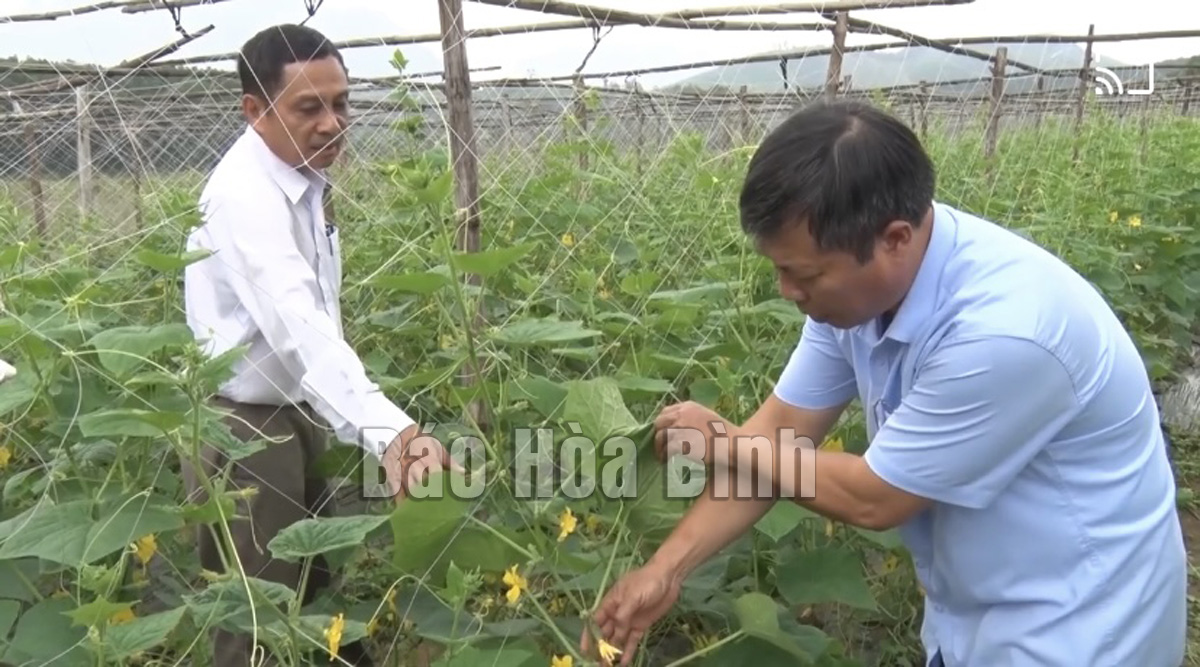
(HBO) - Keeping up with the pace of development of science and technology, in recent years, farmers in Hoa Binh province have changed their thinking in farming and production.
Thanks to that, more households have created profitable production and business models; many groups of farmers have engaged in safe agricultural production and trade, thus forming value chains from production to consumption, applying advanced quality management processes, traceability, helping consumers identify and choose safe food.
A project of connecting production and consumption of cucumbers in Khoan Du commune (Lac Thuy) brings high economic efficiency.
Le Van Thach, Chairman of the provincial Farmers' Union said: Although there are changes for the better in the agricultural production practices of farmers, many farmers still continue with traditional production methods and do not join value chains. The linkages between farmers and businesses are not sustainable. Many contracts are broken, undermining the trust between farmers and businesses. Meanwhile, in the agricultural sector, demand for safe products meeting under VietGAP, GlobalGAP standards is increasing, requiring farmers to cooperate and associate to establish organizations to increase their capacity to meet market demand.
From 2020 till now, farmers’ unions at all levels have coordinated to organize over 280 training courses on VietGAP farming techniques for vegetable, citrus trees, and disease prevention for crops and livestock, benefiting over 124,600 union members. The provincial union has persuaded more than 103,400 member farmer households to sign commitments to ensure food hygiene and safety. The union also helped with the building of 32 agricultural production models applying advanced techniques. It coordinated with relevant agencies to hold four conferences informing regulations on hygiene and safety of agro-fishery-forestry products for 180 owners of establishments engaged in the production, processing and trading of those products.
The union also made recommendations to the authorities on policies on developing cooperation and linkages in the production and marketing of agricultural products, thus pushing the transfer from small-scale independent production by households to production and value chains. In the first six months of this year, farmers’ unions at all levels in the province have helped set up 91 cooperatives and craft production groups./.
According to data from the Hoa Binh Provincial Party Committee, the industrial production index for the first six months of 2025 is estimated to have increased by 20% compared to the same period last year. This marks the highest year-on-year growth rate for this period since 2020.
In the first six months of 2025, Hoa Binh province’s export turnover was estimated at 1.145 billion USD, marking an 18.11% increase compared to the same period in 2024. Import turnover was estimated at $ 804 million, a 17.15% increase, which helped the province maintain a positive trade balance.
The lives of the ethnic minority farmers in Tan Lac district have gradually improved thanks to the new directions in agricultural production. This is a testament to the collective strength fostered through the professional associations and groups implemented by various levels of the district’s Farmers’ Union.
With the motto the "product quality comes first,” after nearly one year of establishment and operation, Muong village’s Clean Food Agricultural and Commercial Cooperative, located in Cau Hamlet, Hung Son Commune (Kim Boi district), has launched reputable, high-quality agricultural products to the market that are well-received by consumers. The products such as Muong village’s pork sausage, salt-cured chicken, and salt-cured pork hocks have gradually carved out a place in the market and they are on the path to obtaining the OCOP certification.
In the past, the phrase "bumper harvest, rock-bottom prices" was a familiar refrain for Vietnamese farmers engaged in fragmented, small-scale agriculture. But today, a new spirit is emerging across rural areas of Hoa Binh province - one of collaboration, organisation, and collective economic models that provide a stable foundation for production.
Maintaining growing area codes and packing facility codes in accordance with regulations is a mandatory requirement for agricultural products to be eligible for export. Recently, the Department of Agriculture and Environment of Hoa Binh province has intensified technical supervision of designated farming areas and packing facilities to safeguard the "green passport" that enables its products to access international markets.



